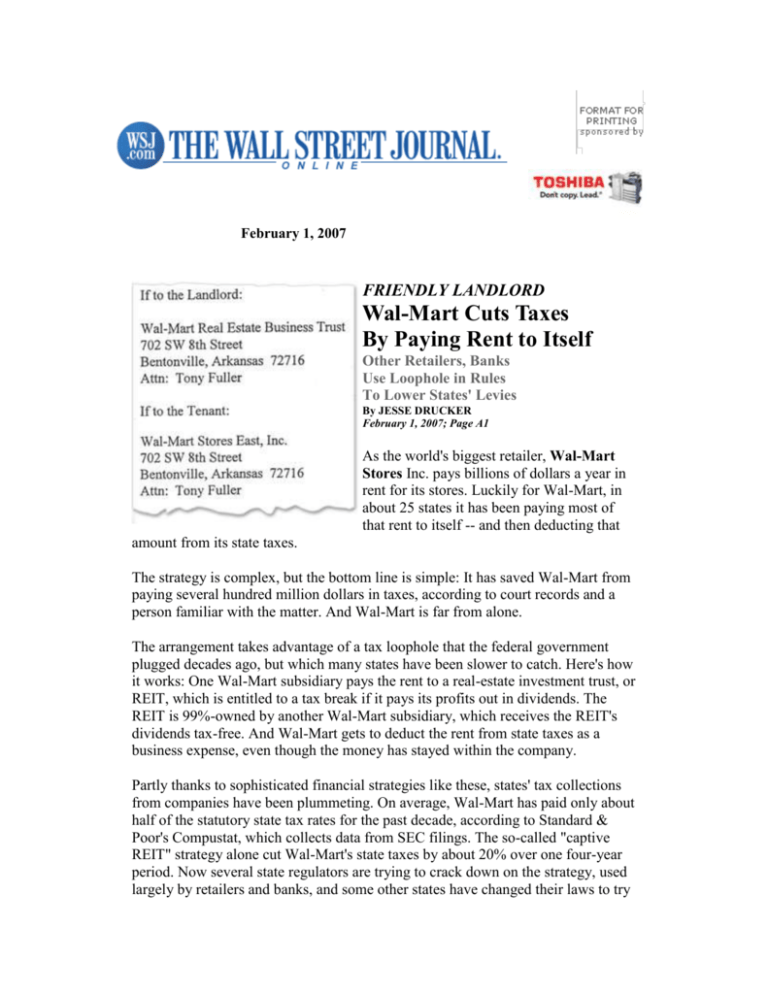
February 1, 2007
FRIENDLY LANDLORD
Wal-Mart Cuts Taxes
By Paying Rent to Itself
Other Retailers, Banks
Use Loophole in Rules
To Lower States' Levies
By JESSE DRUCKER
February 1, 2007; Page A1
As the world's biggest retailer, Wal-Mart
Stores Inc. pays billions of dollars a year in
rent for its stores. Luckily for Wal-Mart, in
about 25 states it has been paying most of
that rent to itself -- and then deducting that
amount from its state taxes.
The strategy is complex, but the bottom line is simple: It has saved Wal-Mart from
paying several hundred million dollars in taxes, according to court records and a
person familiar with the matter. And Wal-Mart is far from alone.
The arrangement takes advantage of a tax loophole that the federal government
plugged decades ago, but which many states have been slower to catch. Here's how
it works: One Wal-Mart subsidiary pays the rent to a real-estate investment trust, or
REIT, which is entitled to a tax break if it pays its profits out in dividends. The
REIT is 99%-owned by another Wal-Mart subsidiary, which receives the REIT's
dividends tax-free. And Wal-Mart gets to deduct the rent from state taxes as a
business expense, even though the money has stayed within the company.
Partly thanks to sophisticated financial strategies like these, states' tax collections
from companies have been plummeting. On average, Wal-Mart has paid only about
half of the statutory state tax rates for the past decade, according to Standard &
Poor's Compustat, which collects data from SEC filings. The so-called "captive
REIT" strategy alone cut Wal-Mart's state taxes by about 20% over one four-year
period. Now several state regulators are trying to crack down on the strategy, used
largely by retailers and banks, and some other states have changed their laws to try
to end the practice. Yesterday, New York Gov. Eliot Spitzer included elimination
of the loophole as part of his proposed budget, a fix he said would bring the state
$83 million a year.
North Carolina tax authorities are challenging Wal-Mart, saying its REIT strategy
was intended to "distort [the company's] true net income," according to its filings in
the case in Superior Court in Raleigh, N.C. The state calls captive REITs a "high
priority corporate tax sheltering issue" and in 2005 ordered Wal-Mart to pay $33
million for back taxes, interest and penalties stemming from the REIT. The
company paid it and last year sued the state for a refund.
The structure Wal-Mart is using features some unusual elements. Because REITs
must have at least 100 shareholders to gain tax benefits, roughly 100 Wal-Mart
executives were enlisted to own a combined total of around 1% of the REIT's
shares, without any voting rights. H. Lee Scott Jr., now Wal-Mart's CEO, was listed
as the REIT's "managing trustee" from 1996 to 2004.
A single Wal-Mart real-estate official, Tony Fuller, represented the company both
as tenant and landlord in its lease with itself. Ernst & Young
LLP, the accounting firm that sold the strategy to Wal-Mart,
also is the company's outside auditor. In its internal sales
training materials, the accounting firm explicitly labeled the
strategy as a method to reduce taxes -- a red flag to tax
authorities, who often demand that tax shelters have other
business purposes.
Wal-Mart attorneys say in court filings that the strategy is
perfectly legal and that North Carolina is exceeding its
authority. A spokesman for the Bentonville, Ark., company,
John Simley, said Wal-Mart "is comfortable with its current
structure and is in compliance with federal and state tax laws."
He added that the REIT structure was adopted to "more
effectively and efficiently manage the company's real-estate portfolio, including the
impact on the company's overall state tax planning."
Regulators in at least a half-dozen states are going after companies that have
trimmed their taxes through similar arrangements, including Regions Financial
Corp.'s AmSouth Bancorp. unit; AutoZone Inc. of Memphis, Tenn.; and two units
of Bank of America Corp. In a Massachusetts case against Bank of America unit
Fleet Funding Inc., authorities call Fleet's REIT arrangement a "sham" in court
filings. They note that Fleet increased the salaries of the roughly 100 employees
whom it made REIT shareholders to compensate them for personal income taxes
stemming from ownership. The Multistate Tax Commission, an association of state
revenue authorities, says it has started examining the use of captive REITs to avoid
taxes, alerting states to the issue and proposing legislative fixes to close the
loophole.
States collected more than $44 billion last year in
corporate income taxes, out of $607 billion in
total state tax receipts, according to the Nelson
A. Rockefeller Institute of Government, a
nonpartisan think tank associated with the State
University of New York. But the average
effective corporate state and local tax rate has
dropped from 6.7% during the 1980s to about
5% during the first half of this decade, according
to a recent report by the Congressional Research
Service. This is in part because of the
proliferation of state and local tax breaks, as well
as tax shelters, according to several academic
and government studies.
Some corporate state tax planners say
arrangements like these are merely smart
business, and that the loopholes exploited by companies should be fixed by state
legislatures rather than litigated by state lawyers. Critics of the shelters complain
they let companies use public services provided by local governments -- such as
police and fire protection or new highways -- without having to shoulder their fair
share of the costs. Meanwhile, the portion of state taxes borne by individuals is
steadily rising.
Congress created REITs in 1960 as a way to allow smaller investors to put money
in a wide portfolio of commercial real estate, spreading their risk. Congress also
gave them a tax benefit: REITs aren't subject to corporate income tax on the profits
they pay to shareholders as long as they pay out at least 90% of the profits. The
shareholders still usually get federally taxed on the dividends, which still count as
income for them.
After a boom in REITs in the early 1990s, big accounting firms including Ernst &
Young and KPMG LLP figured out that on the state level, they could pair the tax
break on REIT dividends with a separate tax rule that allows companies to receive
dividends tax-free from their subsidiaries. With the REIT as a subsidiary itself, two
rules aimed at avoiding double taxation could be combined to effectively avoid any
taxation at all.
The strategy worked especially well if the REIT was owned by a company
incorporated, and claiming to do all its business, in a state such as Delaware or
Nevada that often wouldn't tax the corporate income anyway. That created an extra
hurdle for other states to challenge the practice if they caught onto it.
Ernst & Young early on targeted the banking industry as a possible beneficiary of
the captive REIT strategy. Like retailers, banks have branches in many states and
often are liable for lots of state-level corporate tax. Ernst & Young targeted at least
30 banks, some of them its audit clients. The SEC generally permits that dual role
as long as the firm's fee isn't contingent on the tax savings.
According to documents from a 1995 internal Ernst & Young sales training meeting
reviewed by The Wall Street Journal, the accounting firm suggested banks put
some of their income-producing assets, such as a portfolio of mortgages, into a
REIT subsidiary, then use the double-tax break to "shelter" the income from state
taxes. The REIT would issue a tiny number of non-voting shares to bank "officers
and directors" to meet the 100-shareholder rule that REIT law requires.
U.S. banks "pay millions of dollars each year in state and local taxes," read the
Ernst & Young presentation to its sales force. "The FSI State Tax Financial Product
we have developed can significantly reduce or eliminate this heavy tax
obligation..." One section of the Ernst & Young sales package featured hypothetical
questions from clients about the REIT shelter, and the proposed answers. To pass
legal muster, many corporate tax shelters purport to have additional business
purposes behind merely saving taxes. Ernst & Young, however, was blunt about the
reason for its proposed strategy:
"Q: What's the business purpose?
"A: Reduction in state and local taxes.
"Q: What if the press gets wind of this and portrays us as a 'tax cheat'?
"A: That's a possibility....If you are concerned about possible negative publicity,
you can counter it by reinvesting the savings in the community."
An Ernst & Young spokesman declined to comment on its REIT work, saying the
firm was "prohibited from commenting on client matters." The spokesman said he
could not verify the authenticity of the internal sales training documents based on
quotes provided by the Journal. However, he said the "limited language
communicated in the internal memo does not reflect the quality and nature of the
advice we provide to our clients."
State
authoriti
es have
had
mixed
records
so far in
pursuin
g back
taxes
and
penaltie
s in
captiveREIT
cases.
AutoZo
ne, the
big
autoparts
chain,
won the
right to
deduct
the
dividen
ds from
its taxes
in
Kentuck
y but
lost a preliminary round in Louisiana. The Hawaii Department of Taxation won a
case involving a REIT used by Central Pacific Financial Corp., a bank holding
company. AmSouth is in litigation with Alabama over tax benefits from its REIT.
Fleet Funding's REIT, on which the company was advised by KPMG, has led
Massachusetts to seek more than $42 million in back taxes, interest and penalties.
BankBoston Corp. is in similar litigation with Massachusetts. Both banks have been
acquired by Bank of America, which declined to comment on the litigation.
Fleet's attorneys have said in court papers that its REITs were legitimate, and the
fact that they were partly motivated by tax considerations does not legally
undermine their valid business purpose -- to raise capital, they say. A KPMG
spokeswoman declined to comment on the Fleet case, but said it had stopped any
involvement with "prepackaged tax products" before a 2005 agreement it made
with the U.S. Justice Department over improper tax strategies that also led to the
indictment of 17 former KPMG officials.
It's unknown how many disputes have been raised over the strategy used by WalMart and others, because such tax disputes are generally not disclosed unless
lawsuits are publicly filed or the company reveals them in SEC filings.
Wal-Mart adopted its captive-REIT structure just as it was unwinding a previous
strategy to reduce taxes that states had begun to challenge. For the first half of the
1990s, the retailer used a so-called intangible holdings company structure also used
by many other corporations. Wal-Mart transferred its trademarks to a subsidiary
called WMR Inc. in Delaware, which does not tax many forms of corporate income.
Then it paid the subsidiary for the use of the brands. That allowed Wal-Mart to
deduct those payments from its local income taxes in some states, while WMR's
income wasn't taxed by Delaware.
Several states won challenges to the strategy, used by various retailers. Wal-Mart
settled a dispute over its use of WMR in Louisiana -- the details of the settlement
are sealed -- and lost on the main points of a case in New Mexico. Wal-Mart
merged with WMR in February of 1997 and its use as a state tax avoidance vehicle
was apparently discontinued, according to New Mexico court records.
In the meantime, Wal-Mart set up a new vehicle to control its state tax bill: captive
REITs. In the summer and fall of 1996, Delaware corporate records show, WalMart created a new hierarchy of subsidiaries: a REIT called the Wal-Mart Real
Estate Business Trust; a Delaware-based parent company for the REIT, called the
Wal-Mart Property Co.; and Wal-Mart Stores East Inc., parent of the Delaware
firm. Wal-Mart Property owned 99% of the REIT's shares, and 100% of the voting
shares, according to Wal-Mart court filings in North Carolina and West Virginia.
The company also set up a similar arrangement for its Sam's Club stores.
To meet the 100-shareholder threshold required for REITs, Wal-Mart distributed a
minimal amount of nonvoting stock, to approximately 114 Wal-Mart employees,
according to a person familiar with the arrangement. The dividend payouts were
nominal. The structure involved Wal-Mart's top executive tier. The shareholders
were generally executive vice presidents and above. David Glass, then Wal-Mart's
president and CEO, was listed as president of Wal-Mart Stores East on the lease
agreement, and Paul Carter, then a Wal-Mart executive vice president, was listed as
the president of the REIT.
Wal-Mart began transferring to the REIT ownership of the properties -- the land
and buildings -- for hundreds of its stores in 27 states, real-estate records show.
Then Wal-Mart Stores East signed a 10-year lease agreement with its REIT that
took effect on Jan. 31, 1997, agreeing to pay a fixed percentage of the stores'"gross
sales" as rent, according to a copy of the arrangement filed in the North Carolina
case. Mr. Fuller, the Wal-Mart real-estate official, is listed as the contact for both
the tenant and the landlord. The original lease was due to be renewed this week.
Wal-Mart could deduct from its state-taxable income the rent paid by Wal-Mart
Stores East to the REIT. The REIT paid the majority of its rental earnings to its
99% owner, Wal-Mart Property Co., in the form of dividends. That company's base
in Delaware gave it another way to avoid liability for state taxes, since some states
do require that dividends a REIT pays to its corporate owner be taxed, as the federal
government does.
The Delaware subsidiary then paid the money back to Wal-Mart Stores East, the
same subsidiary that made the payments to the REIT to begin with. Those payments
to Wal-Mart Stores East weren't taxed either, because dividends paid to a
corporation by a subsidiary normally aren't counted as taxable income for the parent
company.
The result of the circuitous transaction: Wal-Mart could effectively turn rental
payments to itself into state level tax-deductions in most of the states where the
payments have been made. Under typical circumstances, rent paid to a third-party
landlord also would reduce taxable income. But that would ordinarily be cash out
the door, like most other tax-deductible expenses. Here, the majority of the taxdeductible rental payments came straight back to Wal-Mart.
The national tax savings have been significant. Over a four-year period, from 1998
to 2001, Wal-Mart and Sam's Club paid company-controlled REITs a total of $7.27
billion that eventually came back to Wal-Mart in states across the country,
according to a North Carolina Department of Revenue auditor's report filed in court
by Wal-Mart. Based on an average state corporate income tax rate of 6.5%, three
accounting experts consulted by The Wall Street Journal estimated the REIT
payments led to a state tax savings for Wal-Mart of roughly $350 million over just
those four years. SEC filings show the company paid $1.18 billion in state taxes
during that period. The loss of federal deductions that bigger state tax payments
would have triggered brought the company's effective tax savings overall down to
about $230 million. Wal-Mart declined to comment on the figures.
It is not clear how much Wal-Mart has paid to its own REITs in the most recent
five years. The yearly rental payments -- on which the tax savings are based -- are
pegged to the "gross sales" of the stores, according to the lease agreement.
Underscoring that the rental payments were cashless Wal-Mart accounting moves,
an affidavit filed in North Carolina by the company's former controller, James A.
Walker Jr., states that the payments were made by simply debiting the account of
one subsidiary and then crediting the account of the other. "Wal-Mart Stores, Inc.
served, in effect, as a bank for" both sides, the affidavit stated.
In 2005, after an audit, the North Carolina Department of Revenue issued a notice
to Wal-Mart challenging the REIT structure. The state is site of about 140 of the
company's roughly 3,900 U.S. stores, including Sam's Clubs. Wal-Mart paid the
$33 million the state sought, and in March 2006 sued for a refund.
The company argues that the state does not have the authority to essentially
combine the results of the subsidiary that did business in North Carolina with those
of the Delaware-based unit and the REIT. The Delaware-based subsidiary, the
company says, did no business in North Carolina and therefore was not taxable
there. The company says in court filings that the REIT was qualified under federal
law, that all the deductions were properly taken and that its North Carolina tax
returns reflect its "true income."
Write to Jesse Drucker at jesse.drucker@wsj.com3
Copyright 2007 Dow Jones & Company, Inc. All Rights Reserved







![HEB Market Analysis[1]](http://s2.studylib.net/store/data/005485404_1-54cabf3bf07d6c92d73f2b15077d5f55-300x300.png)
